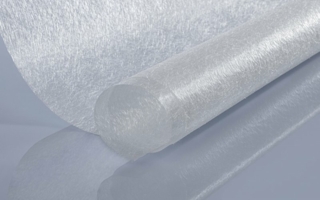16/07/2020 – What is noise? — auf Deutsch lesen
Pssst… Nonwovens for acoustic applications
How noises can be effectively counteracted with nonwovens – an article by Groz-Beckert.
What is noise?
Noise refers to all unwanted loud sounds. These are created by vibrations and spread evenly in the air in the form of sound waves. The louder a noise is, the more people perceive it as an unpleasant noise. But it’s not just the volume that can be perceived as disruptive – specific frequencies are also extremely disruptive for people. A constant or significant noise nuisance can have a major negative impact on a person’s performance or can even lead to illness.
In offices, for example, and in open plan offices in particular, there is often a high level of noise, which impacts health, wellbeing and performance significantly. Modern architecture, with its sound-reflecting surfaces, such as stone floors, floor-to-ceiling glass surfaces and spacious rooms, does not help here. These hard surfaces creates reflections and result in a long reverberation time of the noise, which is often perceived as extremely unpleasant and tiring. This is why it’s particularly important and beneficial to health to combat noise nuisance with sound insulation measures.
How does sound insulation work?
Sound insulation can be achieved with different measures. One measure is “trapping noise in or out”. Loud machines can be shut off from the surroundings with a special enclosure, such as a sound-insulating cabin, thus reducing the noise in a production environment. The sound level can also be reduced both by damping and insulation.
One of the older technically produced insulating materials – made from renewable resources – is mineral bonded wood wool board. These boards were standardized back in 1938 and replaced by the European standard EN 13168 in 2007.
Perforated acoustic elements, such as perforated plate absorbers made from metal, wood or plasterboard, are used in building technology. To improve the room acoustics, some of these acoustic panels are also equipped with an acoustic nonwoven or a mineral fiber mat on the back. But this is not the only use of nonwovens in the field of sound insulation. Thanks to their special properties, they can be used for a whole host of damping and insulation solutions.
Sound insulation with nonwovens
Due to their wide range of properties, different acoustic effects can be achieved with nonwovens. Depending on the surface quality, they can have a sound scattering effect or be used as “sound absorbing materials”. The porous structure of nonwovens means that vibrating air molecules can permeate the nonwoven structure. The air molecules rub against each other there and against the fibers of the structure, which converts the kinetic energy of the molecules into heat through friction losses. This reduces the occurring sound field or, to put it another way, the noise level drops.
Application areas
Nonwovens are being used more and more frequently for sound insulation and damping. In the automotive construction field, for example, they are used to dampen engine noise and ambient noise such as traffic noise in the direction of the passenger compartment. Their sound insulation properties are also used. Absorbers are fitted behind the carpet or dashboard, for example, to reduce the sound field in the passenger compartment.
In the field of room acoustics, nonwovens are being used more and more frequently as absorbing “design objects”. This can take place in the form of individual panels on the wall and/or ceiling, as complete wall and ceiling coverings, in the form of acoustic partitions – for example in open-plan offices – or as complete furniture made from felt.
For insulation and damping, single-origin absorbers are used as far as possible, made from recycled fibers or natural fibers, such as wool, mixed with synthetic fibers.





